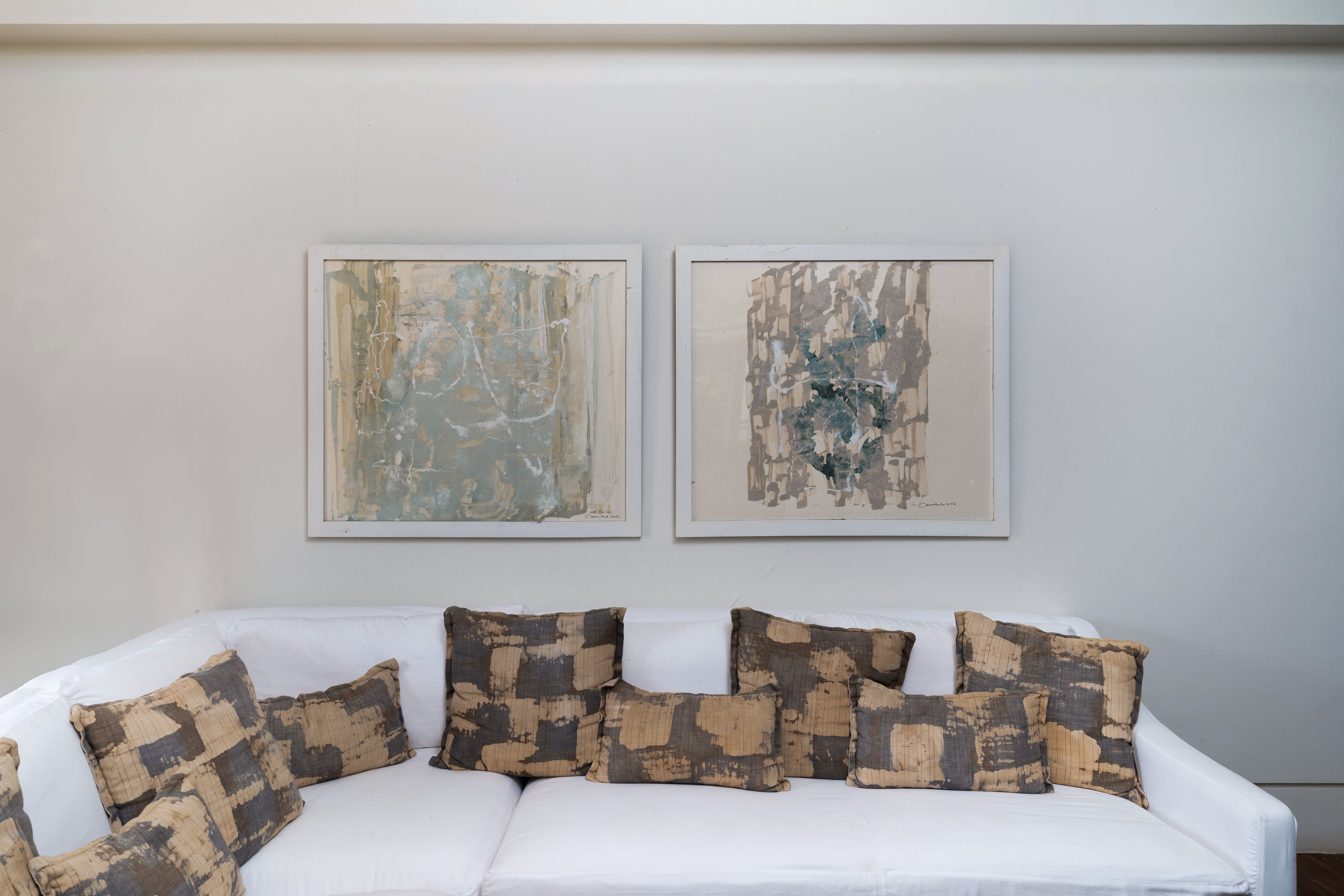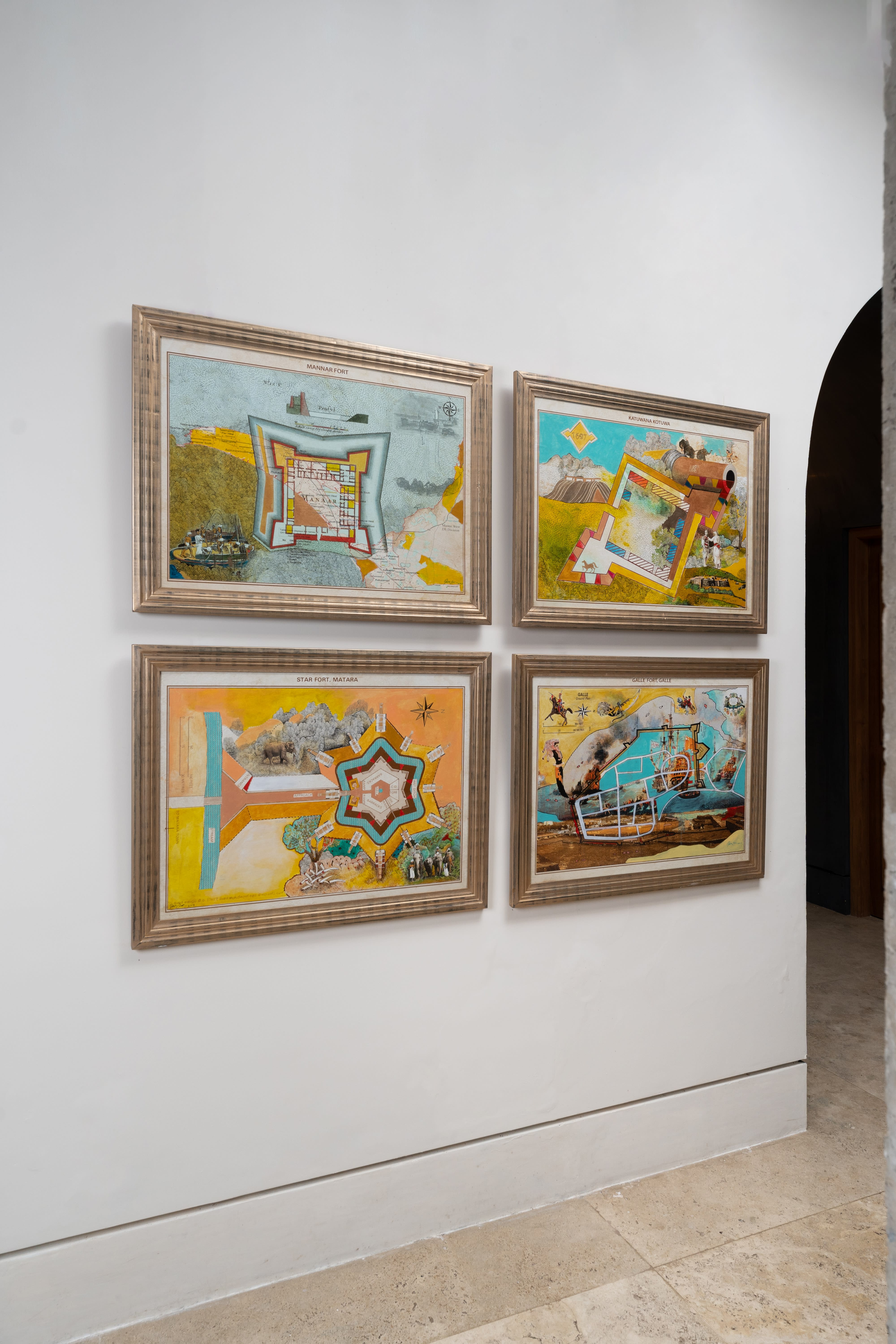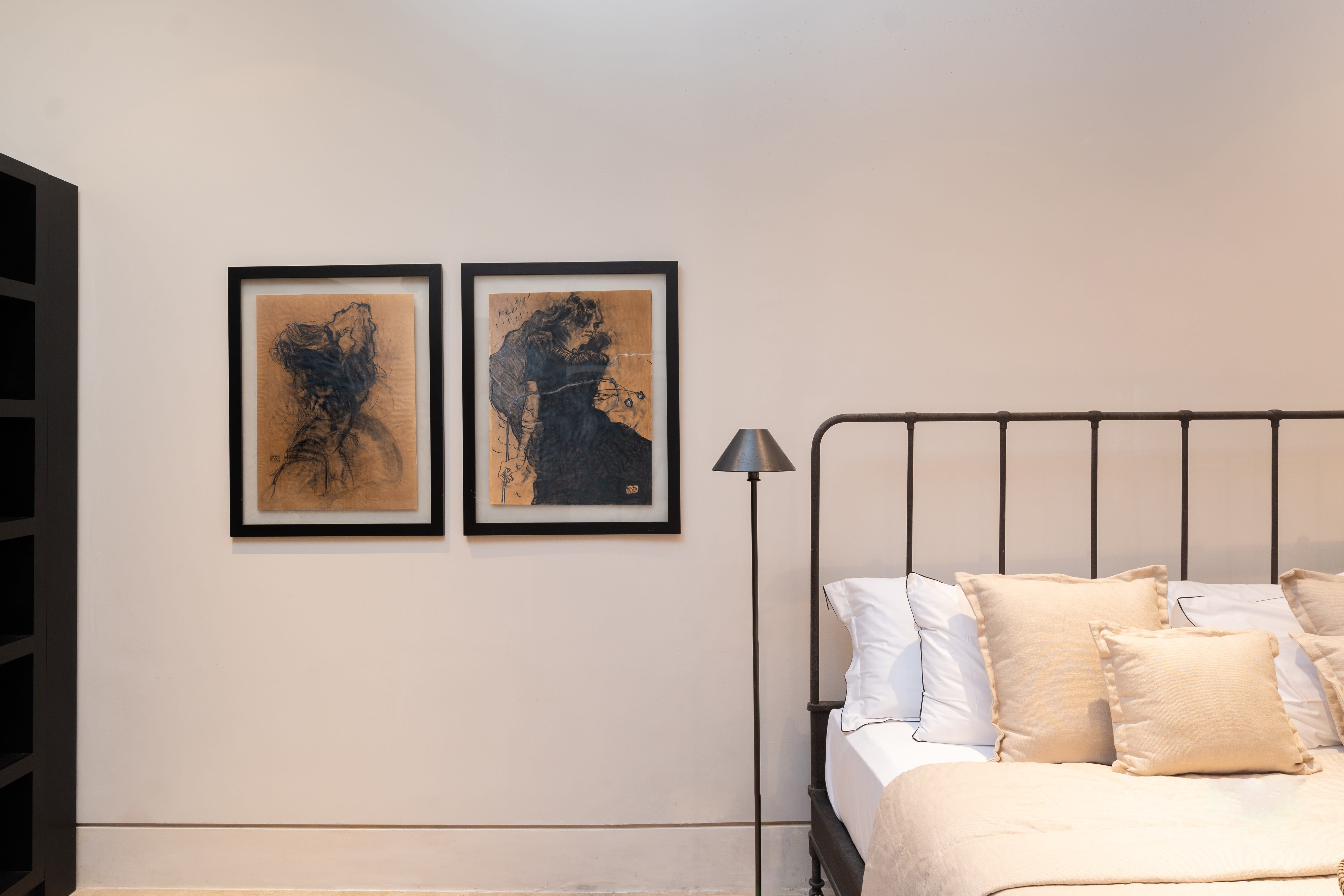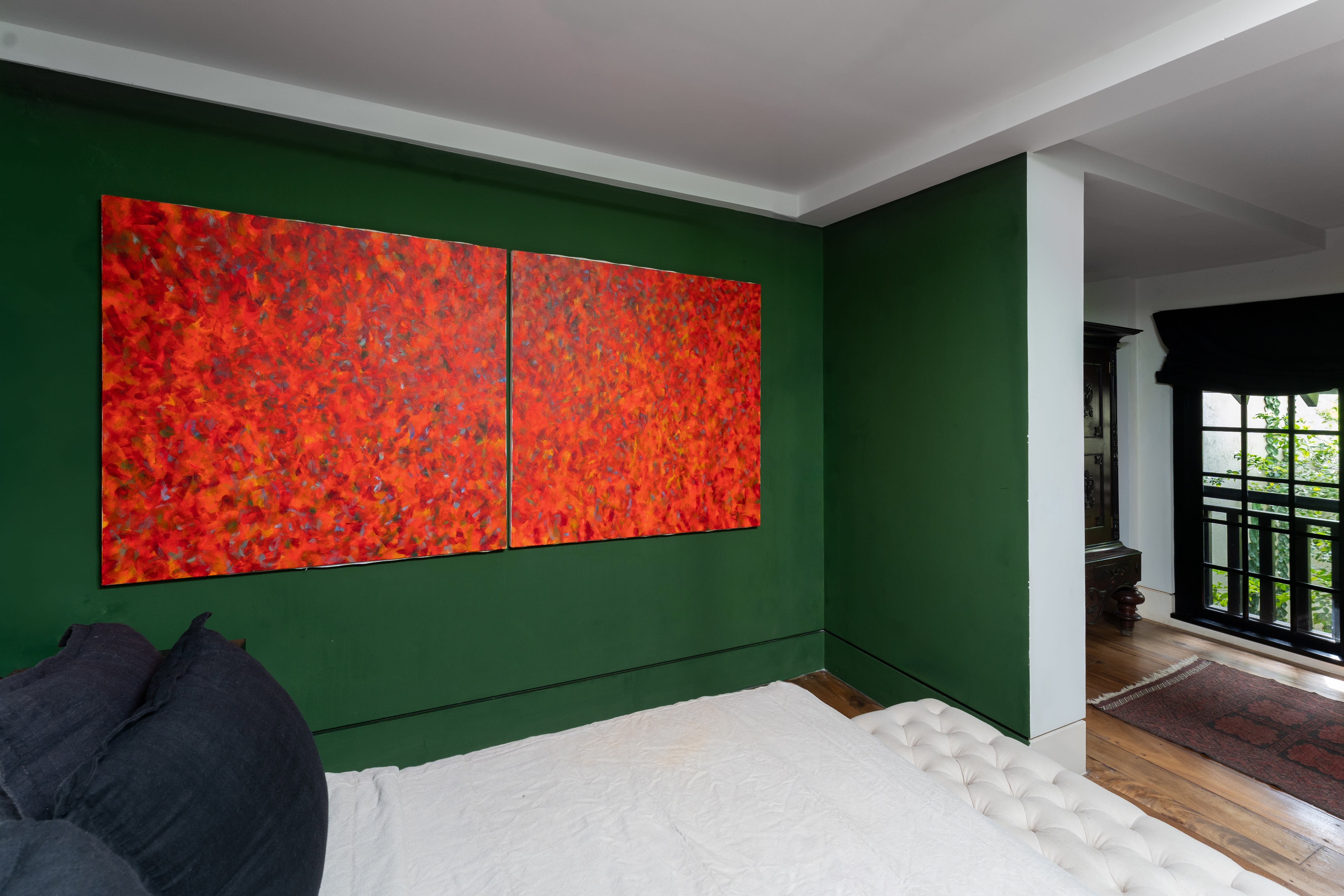 |
Former Sri Lankan cricketer Kumar Sangakkara’s house, No 77 Leyn Baan at the historic Galle Fort, was a six-year-long passion project. In collaboration with architects Jeevaka De Soysa and Murad Ismail, and interior designer Annika Fernando, the Dutch-era mansion was redesigned to incorporate the textured walls of the historical building into the folds of its sleek, contemporary aesthetic. Complemented by an eclectic showcase of contemporary Sri Lankan artists which include Ruwan Prasanna, Hashan Cooray, Mahen Perera, Bandu Manamperi, Yuwantha Yasas, Priyantha Udagedara, Prageeth Manohansa, and H. A. Karunaratne, the space is a celebration of artistic and architectural synergy.

Kumar Sangakkara
Image courtesy: Jonathan and Ryan Wijayaratne
HOW LONG HAVE YOU BEEN COLLECTING ART AND WHAT INSPIRED IT? WHAT IS YOUR EARLIEST MEMORY OF ART? WHAT WAS THE FIRST PIECE YOU FELL IN LOVE WITH, AND WHY.
I grew up in a house surrounded by art. My parents were appreciative of art and had access not just to Sri Lankan art but Sri Lankan artists. Chief among them was George Keyt. He was a good friend of my parents and would visit our house when I was very, very young. He was married to Kusum at the time and there were times he would live and paint in our home as well. My parents still have quite a few of his works along with a collection of letters he wrote them. A few significant pieces of his are stuck in my memory like this one large painting mounted on the living room wall of our home in Kandy that George Keyt painted in that room itself. I remember Keyt’s first and only sculpture; a self-portrait in wood that still sits in an alcove in that same room. I am also fortunate to have Keyt’s final unfinished work which was promised to a close family friend Mr Lal Wijenayake and was presented to him after Keyt’s death by Sachin, Keyt’s son, along with a letter that sits framed with the painting.
While there is danger that the significance of these interactions and experiences may be lost on a very young child looking back I know that they formed the beginnings of my association with and love for Sri Lankan art.
Later on in life, post marriage and the beginning of my cricketing career my connection and association with Sri Lankan art grew stronger through friends, Gallery visits , and meeting more artists. It was at this time I began looking more at contemporary Sri Lankan art and away from the Sri Lankan modernists of the 43 group.
I came across many young artists through Paradise Road Galleries, Barefoot, SFG, the Theertha Collective; through Mr Udayashanth Fernando who was always kind enough to give me a bit of his time and share his thoughts and knowledge, Saskia and Annika; through Jeevaka de Soyza, Murad Ismail, Dominic Sansoni, Chamika De Alwis and also through referrals from artists themselves like Bandu Manamperi and Anoli Perera . It was an exciting and enjoyable journey for me.
Your private collection has a distinct focus on Sri Lankan modern and contemporary. What factors are important to you when collecting a piece of art? What kind of work appeals to you aesthetically and why?
When my appreciation and understanding of Sri Lankan artists and their creative output grew, I focused not just on the artist but also on their creations that Yehali, or I liked or felt connected to. I think it's important to have that personal relationship with a piece, seeing how it appealed to me, rather than just buying something because the artist was either well known or was going to appreciate in value. There were pieces that I chose that some would not be particularly thrilled with, but pulled at me personally.
Of course I have my favorites. Dumith Kulasekera, Anoli Perera among them. Dumith’s first exhibition was at the Harold Pieris at the Lionel Wendt Art Centre. I managed, with Saskia's assistance, to secure a piece that I absolutely loved. There are other significant pieces I love such as abstract work by H. A. Karunaratne.
I think when I do buy, it is both an interplay between how I build a relationship with a particular artist, without ever having seen their work and also seeing works in isolation. Working out how they appeal to me rather than a hugely educated or analytical view of a particular piece. Sometimes that comes later. It's just very subjective.
Artworks by H A Karunaratne (2016) Image courtesy: Harin Katipearachchi
|
When placing works in 77 Leyn Baan you chose predominantly contemporary works, some are exhibited works by artists and some commissioned, can you tell us more about how this collection grew?
I think it evolved. I had purchased a lot of the pieces over the years because I liked and enjoyed them. Except for one piece the rest were all collected centrally and not specifically for the renovation.
77 Leyn Baan had a great foundation for being something special. When we walked in for the first time, not having seen the place before purchasing it, we could see what the house could become. We always wanted the traditional bones and Dutch architecture brought into the house but to flesh it out with something very contemporary. I had already spoken to Annika to come on board with us with the project. I can’t believe she had the patience and passion to stay with us through the 6 years the project took. Without her it would never have come to be. Initially we worked with architect Jeevaka de Soysa but he had to withdraw later. Mu friend Murad Ismail kindly agreed to assist us after that and really brought the project together. We always wanted it to be an eclectic but refined mixture of furniture and art. Irrespective of eras expressions of creativity and craftsmanship done the right way, always sit beautifully together and even in clashing brings harmony.
We wanted each space to have its own character. In the front room with the green wall and black lacquered ceilings hang works by Priyantha Udagedara and Yuwantha Yasas. A work by Ruwan Prasanna from his Komorebi exhibition - a cacophony of colours - sits behind the dining table. There is a David Weeks's Bottled Tier mobile hanging above the dining table that lights up the space. We have a Prageeth Manohansa early bull drawing in the living area connected to the dining area. You now see a lot of similar sketches and works in many of the places in the fort but at the time we wanted to have an arresting sizable piece there.
Ruwan Prasanna, Komorebi IV (2017) Image courtesy: Harin Katipearachchi
I really enjoyed the paper works Anima Animus by Hashan Cooray, though a little morbid at times. I think when you're in a bedroom it has to make you more contemplative, and the works by Hashan makes you think a little bit. Each part of the house has a story behind it. Annika had this incredible capability to make our crazy, and nonsensical ideas look beautiful. There is a beautiful, textural piece by Mahen Perera. When you see it in line with the original wall, Mahen’s work and the wall contrast but also complement each other, together with the Sonali Dharmawardena batik-work cushions. It's almost as if these little features have influenced each other and inspired each other blurring the sequence of which actually came before the other; asking in that context does it even really matter?
Prageeth Manohansa, Bull, Mahen Perera, Splatter Wall I (2018) Image courtesy: Harin Katipearachchi
The Prageeth Manohasa pot that sits on top of the first courtyard was purchased before the house renovation started. When we saw that courtyard we knew it was going to be the perfect centerpiece but because of its size, we had to move in the pot during pre-construction. It sat there for all that time rusting away, as the home grew around it and we placed it where it sits today.
Prageeth Manohansa, The Big Pot (2013) Image courtesy: Harin Katipearachchi
Originally from the front room towards the courtyard were a pair of arches you walked through. I remember Yehali and I sitting with Jeevaka De Soysa and Annika and discussing combining the arches to form a vaulted passage. It is reminiscent of the side entrance and the main entrance to the Galle Fort. I thought it was slightly insane at the start but it became this wonderful entrance into the courtyard. It frames both the front sitting room and Prageeth Manohansa’s Pot. The composition of this space became one of my favourite walkthroughs in the house.
The one piece we did commission specifically for Leyn Baan was Spectators by Prageeth Manohansa. It sits right above the pot on the upper terrace and seems to gaze through the house towards the sea and down into the lower courtyard while you gaze back at them.
Annika was wonderful in understanding what we wanted, accommodating it, but also being firm in the way of leading us to understand how a space would work better with a different option. She was immersed in the renovation even more than us and her creative hand has touched every single piece of art, furniture,fabric and every inch of space in the house. For us, it was a huge labour of love. We wanted the house to be arresting; we wanted it to be different.
|
You have a series of works by Sri Lanka's leading abstract contemporary artist H A Karunaratne in Leyn Baan. Can you tell us about your relationship with the artist?
There is a series by H A Karunaratne in the master bedroom at Leyn Baan which I absolutely adore. I was fortunate enough to meet him. I was sitting down in my house at Hokandara with Bandu Manamperi who was talking about H A Karunaratne with such reverence, and he offered to introduce me to him. H A Karunaratne very graciously invited me into his house and we had a long chat over a few cups of Japanese tea.
You can see the Japanese aesthetic in his later work, especially the ones that I have. The personal interaction with the artist was as important to me as much as the work he was producing. The short time that I have interacted with him was quite interesting. He was very advanced in years when I met him. He was very easy to talk to, and he was painting a lot even at that stage.
He told me how he tried to represent in a tangible way the thoughts streaming through his mind every day. He attempted to capture them on canvas, on a piece of paper, on board or as a sculpture. He was trying to capture all of them in his work. I found it quite fascinating.
When you did talk to him, a lot of it was not just about art, it was also about his general life experiences in Sri Lanka and abroad. I think he's just phenomenal. His mental acuity, even at his advanced age was incredible and I could understand why the younger artists I have spoken to spoke about him with such reverence.
|
Artworks by H A Karunaratne
Image courtesy: Harin Katipearachchi
Your collection features commissioned pieces by Pala Pothupitiya examining the colonial history of the Galle Fort. Could you tell us a bit more about the series?
Uncle Jeevaka (Architect Jeevaka de Soysa) had mentioned Pala Pothupitiya originally to design the balustrade railing around the gallery. He was a young artist at the time. Once my son Kavith was ill in hospital. Uncle Jeevaka came to see him and he brought this young, thin man with slightly curly, unkempt hair. It was Pala Pothupitiya. I had seen his work at Saskia’s when her gallery was at Dharmapala Mawatha.
Pala and I talked about his works with maps and I asked him if it was possible to expand on that idea but with the footprint of Dutch forts around Sri Lanka. We discussed how they could be represented in his detailed manner, to explore their relevance, significance and historical aspects. He had initially done some sketches on parchment paper but I asked for them to be made on canvas.
I wanted all the forts to be framed almost like a jigsaw so that you could place all of them together or separate them, so that if you did keep them together they would fit in seamlessly and if you wanted to hang them individually, you could. But we moved a little bit away from the idea and each was given its individual place in the house in little groupings.
That is how we have the forts from Trincomalee, the Star Fort in Matara to Fort Frederick, the Fort in Negombo, his interpretation of Galle Fort with the cricket stadium in the background. The largest one he did was of fort in Colombo. Unfortunately, it was too big for Leyn Baan.
|
Pala Pothupitiya, Commissioned reinterpretations of Sri Lankan Dutch Forts Image courtesy: Harin Katipearachchi |
Senior contemporary practitioners such as HA Karunaratne and Pala Pothupitiye are juxtaposed with emerging practitioners Hashan Cooray, Ruwan Prasanna and Prageeth Manohansa. What is it that guides your interest in these different artistic trajectories?
For me it is not just an artist's or his collectability as they grow in stature and in recognition. It is also about the experiences of the artists that are depicted in their output. You often notice the deviation from the originality of an artist when they become over-commercialized. From working with artists one understands the conflict between earning a living and creating a well-conceptualized piece of work. You sometimes see a repetitive nature of work that comes along with that pressure.
The artist could have also deviated from a particular line of thought and would have had different experiences in life. Dumith Kulasekara is a great case in point, especially when you consider the work he created when he started. The work he creates now are influenced by his experiences in South Korea, and Europe, particularly Renaissance art.
I might commission a piece and have a chat with the artist, rather than imposing something I want. The conversations I have with them are to better understand whether it’s the right time to commission a piece. It's a conversation and connection.
It's interesting for me to look back on the relationships I've had and at what stage I connect with a piece or an artist. Sometimes, when you see a work you have seen before, you wonder if it is as meaningful as it was five years ago when I first saw it. I do follow certain artists that I have really enjoyed and have collected but it's not the case that I willl buy something from every exhibition.
I think that is one of the reasons why I have a collection of artists at various stages in their careers and artists with varying trajectories - some who have kept on growing, others may have perhaps stayed the same and others may have deviated. The personal experiences of an artist, the exposure, not just to the changing states of their surroundings, societies, politics and life but also their travel of the world and their emotional states matter in terms of what an artist creates.
Hashan Cooray, Anima Animus I & III (2018) Image courtesy: Harin Katipearachchi
|
What is one of the most sentimental pieces in your collection at Leyn Baan? Do you have a favourite work at Leyn Baan?
I think the maps by Pala Pothupitiya are really special to me. They are very personal because I remember him coming to the hospital to see my son and then we sat down and went from discussing a brass railing over a staircase to the maps he created for us. I love the works of Mahen Perera. The Prageeth Manohansa Pot was there while the house was being renovated. It was always meant to be somewhere in the house. It was always in the vicinity of where it ended up so it is almost as if the house embraced it. I think the whole beauty of Leyn Baan is that the art just seemed to fit beautifully inside it.
|
Do you have any favourite artists you are following at the moment? Who is an artist you look forward to collecting?
I think Anoli Perea is amazing. I don’t have any work by Firi Rahman and I think he is also quite fascinating. I also find Muvindu Binoy and Abdul Halik Azeez very interesting. I am also hoping to access some of H A Karunaratne’s early works. I remember Sanjeewa Kumara’s first exhibition he had at Paradise Road which was so very good. I find Susiman Nirmalavasan’s work very striking. I also want to see where Dumith Kulasekara goes with his art. I also enjoy chatting with Bandu Manamperi. I think he has incredible insight. He is very open about his university days, his interpretation of politics, how it relates to his art and his performance works. I’ve spent months talking and arguing with him over cups of coffee and tea at home.
|
Can you tell us more about any particular series that you love for the house?
In addition to the works by HA Karunaratne and Pala Pothupitiya, there are also these works by Cassie Machado, which I loaned to the the MMCA for an exhibition which I absolutely love. It was a series of photographs wherein she witnessed the aftermath of the war, depicting an album semi destroyed and burnt. Susiman Nirmalavasan’s series of twelve works on billowing curtains featuring mothers from the North is another piece in my collection that I find incredible. I’m not sure how I will fit these in to the house though.
Ruwan Prasanna, Komorebi XIII (2017) Image courtesy: Harin Katipearachchi
|
How does the Leyn Baan collection differ from your private collection in your Colombo home?
With Leyn Baan’s history, we were quite determined to have a mix of contemporary and modern art. In my collection at home, I have a few Sri Lankan masters such as Justin Pieris Deraniyagala, David Paynter, George Keyt and George Claessen. The walls of certain houses can take art as if they belong there while others do not. It was a case of understanding with Annika how the pieces fit in with what Leyn Baan meant to us; what the journey was like and who were the artists we wanted represented in the space.
Leyn Baan was just perfect for contemporary artists because of its historical context in the Galle Fort, a World Heritage Site. The juxtaposition, of the contemporary and the historical, works incredibly well.
But the the pieces inside Leyn Baan cannot be isolated for me from the rest of my art. They are a part of a whole.
Prageeth Manohansa, Spectators (2017) Image courtesy: Harin Katipearachchi |








